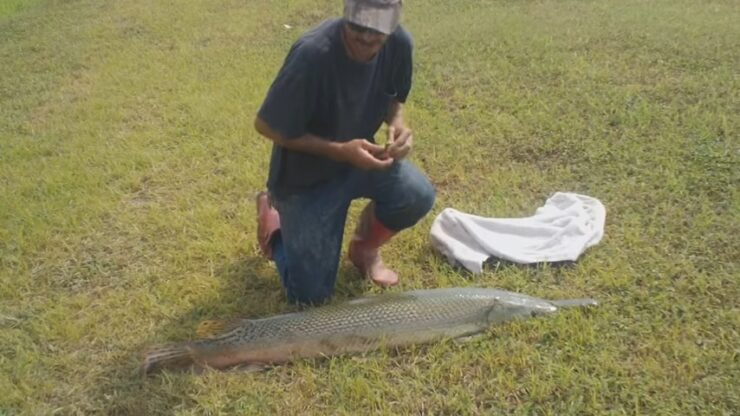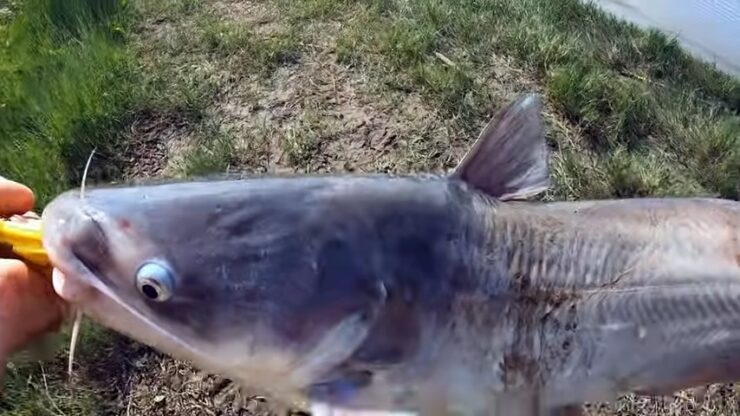Summers in Mississippi are the epitome of sweltering heat, drawing people to the refreshing waters of rivers and lakes. Children shriek with delight as they’re towed on inflatables behind boats, while others intermittently take a dip as they unwind on sandy banks.
Water-based escapades are typically worry-free, yet lurking below the water’s surface lie enormous aquatic creatures, among them a seldom-seen freshwater dweller with lethal tendencies.
Let’s dive into the world of fishing in Mississippi and explore the largest fish that live in its waters.
No Bull Shark
Bull sharks (Carcharhinus leucas) are a species of shark that can tolerate both saltwater and freshwater environments. They have been known to swim up rivers and have been found in various rivers around the world, including the Mississippi in the United States.
Although sightings are relatively rare, there have been confirmed cases of bull sharks being found in the Mississippi River as far upstream as Illinois. However, these instances are infrequent and should not be considered a common occurrence.
They are a unique and fascinating species of shark that are known for their adaptability and aggressive nature. They are medium to large-sized sharks, with adult females reaching lengths of up to 11 feet (3.4 meters) and males measuring around 7 feet (2.1 meters).
The name “bull shark” is derived from their stocky body shape, short blunt snout, and aggressive behavior, which is reminiscent of a bull.
Garzilla
“Garzilla,” which is often used to describe exceptionally large alligator gar caught by anglers. Alligator gar (Atractosteus spatula) are large, prehistoric-looking fish that inhabit freshwater environments, including rivers, lakes, and swamps, primarily in the southeastern United States.
The Mississippi is one of the habitats where alligator gar can be found.
Fishing for alligator gar in the Mississippi River can be an exciting and challenging experience for anglers. Techniques for catching alligator gar often involve using large baitfish, such as carp or shad, on heavy-duty fishing gear. It is essential to use strong hooks, lines, and leaders to handle these powerful fish. Additionally, using a large net or a gaff can be helpful when landing a gar.
Uber Cat
“Uber cat” might is a term used to describe particularly large catfish caught by anglers. Mississippi is home to several species of catfish, including blue catfish, channel catfish, and flathead catfish. These species are popular targets for sport fishing enthusiasts due to their size and the challenge they offer.
Blue catfish (Ictalurus furcatus) are the largest species of catfish in North America, with some individuals reaching lengths of over 5 feet (1.5 meters) and weighing more than 100 pounds (45 kilograms). Channel catfish (Ictalurus punctatus) and flathead catfish (Pylodictis olivaris) are also sizable, with the largest individuals weighing up to 50 pounds (22 kilograms) and 120 pounds (54 kilograms), respectively.
Fishing for catfish in the Mississippi River can be a fun and rewarding experience for anglers. Common techniques for catching catfish include using bait such as cut bait, live baitfish, nightcrawlers, or commercial stink bait on a bottom rig or slip-sinker rig. Night fishing can be particularly productive, as catfish are often more active during the twilight and evening hours.
The Gulf sturgeon
The Gulf sturgeon (Acipenser oxyrinchus desotoi) is a subspecies of the Atlantic sturgeon and is native to the Gulf of Mexico and some southeastern U.S. rivers, including the Mississippi River. They are large, prehistoric-looking fish that can reach lengths of up to 8 feet (2.4 meters) and weigh over 200 pounds (90 kilograms).
Gulf sturgeon have elongated bodies covered in bony plates, called scutes, and a long snout with sensitive barbels for detecting prey on the riverbed.
Gulf sturgeon are anadromous, meaning they migrate between freshwater and saltwater environments. They typically spend their summers in freshwater rivers, such as the Mississippi River, before returning to the Gulf of Mexico’s estuaries and coastal areas in the fall and winter. During their time in freshwater, they feed on a diet of aquatic insects, worms, and small crustaceans.
However, it is important to note that Gulf sturgeon are listed as threatened under the U.S. Endangered Species Act, and it is illegal to fish for or harm them in any way. Conservation efforts have been implemented to protect and restore their populations, including habitat restoration, research, and monitoring programs.
If you happen to accidentally catch a Gulf sturgeon while fishing for other species, it is crucial to release it immediately and take care not to harm the fish.
Using barbless hooks or circle hooks can help minimize potential injury when releasing the fish. By following local regulations and guidelines and practicing responsible fishing methods, anglers can help protect these ancient and unique fish species for future generations.
Freshwater Shark
The term “freshwater shark” can be used to describe various fish species that resemble sharks but are not true sharks. In the context of the Mississippi River, this term might be applied to the alligator gar or the bowfin, which have elongated bodies and a somewhat shark-like appearance. However, it is important to note that neither of these species are true sharks.
- Alligator gar (Atractosteus spatula): As mentioned earlier, alligator gar are large, prehistoric-looking fish that inhabit freshwater environments, including the Mississippi River. They are popular among anglers due to their size and the challenge they present. Techniques for catching alligator gar typically involve using large baitfish on heavy-duty fishing gear.
- Bowfin (Amia calva): Bowfin are another ancient fish species native to the Mississippi River and other freshwater systems in North America. They have elongated bodies, large mouths filled with sharp teeth, and a long dorsal fin that extends along their backs, giving them a shark-like appearance. Bowfin can reach lengths of up to 9 feet (3 meters) and are aggressive predators, feeding on fish, crayfish, and other aquatic organisms.
When fishing for bowfin, anglers often use live bait, such as minnows or small fish, on a slip-sinker rig or float rig. Artificial lures, such as spinnerbaits, crankbaits, or soft plastic lures, can also be effective. Bowfin are known for their fighting abilities, making them an exciting catch for anglers.
As always, it is essential to follow local fishing regulations and guidelines when targeting any species in the Mississippi River. Practicing responsible fishing methods and supporting conservation efforts can help protect these fascinating fish species and their ecosystems for future generations.
Conclusion
The Mississippi River and its surrounding waters offer a diverse and fascinating array of fish species for anglers to target. From bull sharks to alligator gar, and from large catfish to Gulf sturgeon, these ancient and unique creatures provide exciting and challenging fishing experiences.
When exploring the world of fishing in Mississippi, it is crucial to follow local regulations and guidelines, practice responsible fishing methods, and support conservation efforts to ensure the continued survival of these incredible fish species. By doing so, we can help protect the biodiversity and ecological health of the Mississippi River for future generations to enjoy.



















